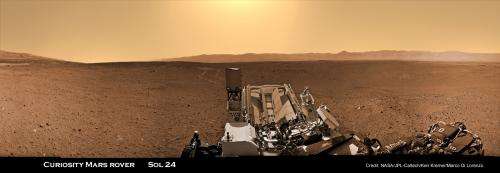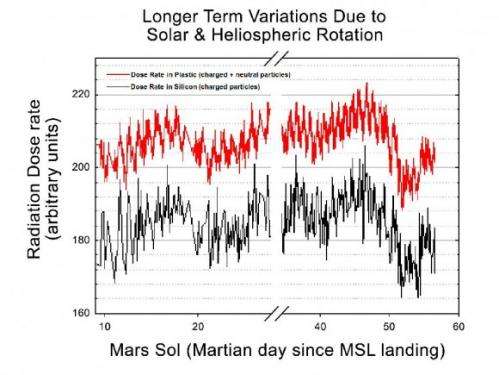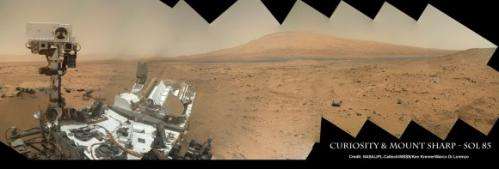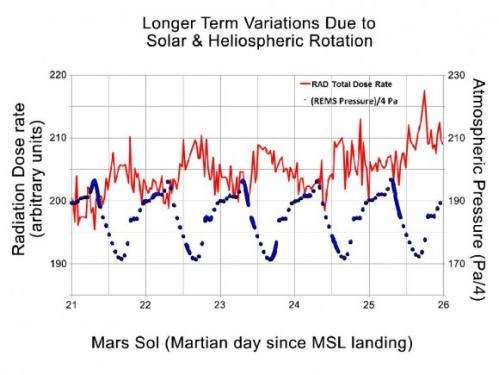Can humans live on Mars?

Metallic robots constructed by ingenious humans can survive on Mars. But what about future human astronauts?
NASA's plucky Mars Exploration Rover Opportunity has thrived for nearly a decade traversing the plains of Meridiani Planum despite the continuous bombardment of sterilizing cosmic and solar radiation from charged particles thanks to her radiation hardened innards.
How about humans? What fate awaits them on a bold and likely year's long expedition to the endlessly extreme and drastically harsh environment on the surface of the radiation drenched Red Planet - if one ever gets off the ground here on Earth? How much shielding would people need?
Answering these questions is one of the key quests ahead for NASA's SUV sized Curiosity Mars rover – now 100 Sols, or Martian days, into her 2 year long primary mission phase.
Preliminary data looks promising.
Curiosity survived the 8 month interplanetary journey and the unprecedented sky crane rocket powered descent maneuver to touch down safely inside Gale Crater beside the towering layered foothills of 3 mi. (5.5 km) high Mount Sharp on Aug. 6, 2012.
Now she is tasked with assessing whether Mars and Gale Crater ever offered a habitable environment for microbial life forms – past or present. Characterizing the naturally occurring radiation levels stemming from galactic cosmic rays and the sun will address the habitability question for both microbes and astronauts. Radiation can destroy near-surface organic molecules.

Researchers are using Curiosity's state-of-the-art Radiation Assessment Detector (RAD) instrument to monitor high-energy radiation on a daily basis and help determine the potential for real life health risks posed to future human explorers on the Martian surface.
"The atmosphere provides a level of shielding, and so charged-particle radiation is less when the atmosphere is thicker," said RAD Principal Investigator Don Hassler of the Southwest Research Institute in Boulder, Colo. See the data graphs.
"Absolutely, the astronauts can live in this environment. It's not so different from what astronauts might experience on the International Space Station. The real question is if you add up the total contribution to the astronaut's total dose on a Mars mission can you stay within your career limits as you accumulate those numbers. Over time we will get those numbers," Hassler explained.
The initial RAD data from the first two months on the surface was revealed at a media briefing for reporters on Thursday, Nov. 15 and shows that radiation is somewhat lower on Mars surface compared to the space environment due to shielding from the thin Martian atmosphere.
RAD hasn't detected any large solar flares yet from the surface. "That will be very important," said Hassler.
"If there was a massive solar flare that could have an acute effect which could cause vomiting and potentially jeopardize the mission of a spacesuited astronaut."
"Overall, Mars' atmosphere reduces the radiation dose compared to what we saw during the cruise to Mars by a factor of about two."
RAD was operating and already taking radiation measurements during the spacecraft's interplanetary cruise to compare with the new data points now being collected on the floor of Gale Crater.

Mars atmospheric pressure is a bit less than 1% of Earth's. It varies somewhat in relation to atmospheric cycles dependent on temperature and the freeze-thaw cycle of the polar ice caps and the resulting daily thermal tides.
"We see a daily variation in the radiation dose measured on the surface which is anti-correlated with the pressure of the atmosphere. Mars atmosphere is acting as a shield for the radiation. As the atmosphere gets thicker that provides more of a shield. Therefore we see a dip in the radiation dose by about 3 to 5%, every day," said Hassler.
There are also seasonal changes in radiation levels as Mars moves through space.
The RAD team is still refining the radiation data points.
"There's calibrations and characterizations that we're finalizing to get those numbers precise. We're working on that. And we're hoping to release that at the AGU [American Geophysical Union] meeting in December."

Radiation is a life limiting factor to habitability. RAD is the first science instrument to directly measure radiation from the surface of a planet other than Earth.
"Curiosity is finding that the radiation environment on Mars is sensitive to Mars weather and climate," Hassler concluded.
Unlike Earth, Mars lost its magnetic field some 3.5 billion years ago – and therefore most of it's shielding capability from harsh levels of energetic particle radiation from space.
Much more data will need to be collected by RAD before any final conclusions on living on Mars, and for how long and in which type habitats, can be drawn.
Learn more about Curiosity and NASA missions at my free public presentation on Dec. 6 held at Brookdale Community College, Monmouth Museum, Lincroft, NJ at 8 PM – hosted by STAR astronomy. And watch the PBS NOVA Mars documentary – 'Ultimate Mars Challenge' - which also features Curiosity mosaics created by the imaging team of Ken Kremer & Marco Di Lorenzo.
More information: www.universetoday.com/98395/ul … ry-premieres-nov-14/
Source: Universe Today


















